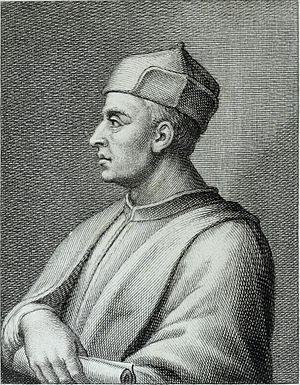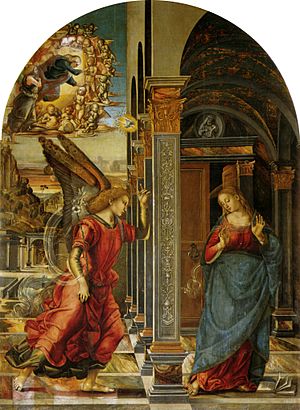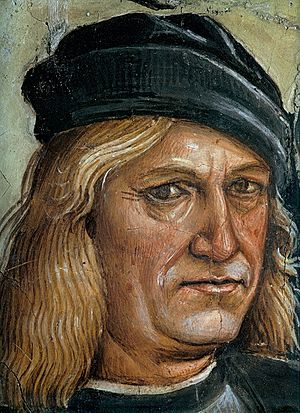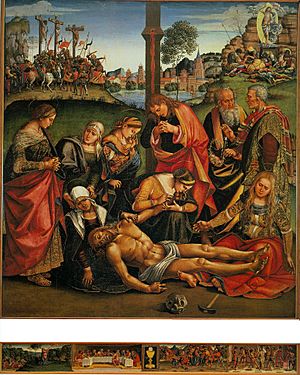Luca Signorelli facts for kids
Quick facts for kids
Luca Signorelli
|
|
|---|---|

Portrait of Luca Signorelli, from Serie degli uomini. I più illustri nella pittura, scultura, e architettura, III (1769)
|
|
| Born |
Luca d'Egidio di Ventura
1441 Cortona, Italy
|
| Died | 16 October 1523 (aged 81–82) Cortona, Italy
|
| Nationality | Italian |
| Known for | Painting |
| Movement | Early Renaissance |
| Spouse(s) | Gallizia di Piero Carnesecchi |
Luca Signorelli (born around 1441/1445 – died October 16, 1523) was an important Italian Renaissance painter. He came from Cortona in Tuscany, Italy. He was especially known for his amazing drawing skills and how he used foreshortening. This is a technique that makes objects look like they are coming out towards you or going back into the distance.
His most famous works are the huge frescoes (wall paintings) of the Last Judgment (1499–1503) in Orvieto Cathedral. These are considered his greatest achievement.
When he was in his early 40s, Signorelli moved back to Cortona. Before that, he had worked in big cities like Florence, Siena, and Rome. He even painted a part of the Sistine Chapel in Rome (though that part is now lost). Once he became famous, he stayed in Cortona for the rest of his life. However, he often traveled to nearby cities to complete art projects. He probably learned to paint from Piero della Francesca in Florence.
Cortona planned a special exhibition in 2023 to celebrate 500 years since his death.
Contents
About Luca Signorelli
Luca Signorelli was born Luca d'Egidio di Ventura in Cortona, Tuscany. Some people also called him Luca da Cortona. We don't know his exact birth date, but it was likely between 1441 and 1445. He passed away in 1523 in his hometown of Cortona, where he is buried. He was probably around 78 to 82 years old.
He is considered part of the Tuscan school of painting. However, he also worked a lot in Umbria and Rome. His first ideas about art came from Perugia, where he saw the styles of artists like Benedetto Bonfigli and Pinturicchio.
Luca's uncle, Lazzaro Vasari, was the great-grandfather of the famous art historian Giorgio Vasari. According to Giorgio Vasari, Lazzaro helped Luca become a student of Piero della Francesca. By 1472, young Luca was painting in Arezzo, and in 1474, he was in Città di Castello.
He gave a painting called School of Pan to Lorenzo de' Medici, a powerful leader in Florence. This painting was later found in Florence around 1870 and sold to a museum in Berlin. Sadly, it was destroyed during World War II. The painting showed the god Pan, along with Olympus, Echo, a man resting, and two shepherds listening.
Signorelli worked in Rome from 1478 to 1484. In 1484, he returned to Cortona, which remained his home until he died. He painted eight frescoes in the Monastery of Monte Oliveto Maggiore near Siena. These were part of a large series showing the life of Saint Benedict. He also painted classical and mythological scenes in the palace of Pandolfo Petrucci, including another version of School of Pan. Signorelli stayed healthy and kept painting until his last year. One of his final works was an altarpiece for a church in Foiano.
His Masterpiece: Orvieto Cathedral
After working at Monte Oliveto Maggiore, Signorelli went to Orvieto. There, he created his most famous work: the frescoes in the Chapel of S. Brizio (also called the Cappella Nuova) inside the Orvieto Cathedral.
Another artist, Fra Angelico, had already started painting two parts of the chapel's ceiling about 50 years earlier. Signorelli added to this by painting scenes about the Apocalypse and the Last Judgment. These scenes cover the ceiling and upper walls of the large chapel.
The story of the Apocalypse starts with the Preaching of Antichrist. It then moves to Doomsday and The Resurrection of the Flesh. These are shown in three huge curved sections, each telling a continuous story. In one scene, the Antichrist falls headfirst from the sky into a huge crowd of people.
The events of the Last Judgment fill the opposite wall and the areas around the altar. This series includes Paradise, the Elect and the Condemned, Hell, the Resurrection of the Dead, and the Destruction of the Reprobate.
Signorelli added to Fra Angelico's ceiling, which showed Christ judging and prophets. Signorelli painted the Madonna leading the Apostles, Patriarchs, Church Doctors, Martyrs, and Virgins. All these paintings are connected by readings from the Bible used in church services.
Signorelli's paintings were very bold and powerful for their time. They showed difficult foreshortening techniques. It is believed that Michelangelo might have used some of Signorelli's figures or ideas in his own famous fresco in the Sistine Chapel. The lower walls of the chapel are also beautifully decorated. They include scenes related to Dante's Purgatorio, and stories from ancient poets and legends. One painting, a Pietà, shows references to two important saints from Orvieto.
Signorelli signed a contract for this work on April 5, 1499. He agreed to finish the ceiling for 200 ducats and the walls for 600 ducats. He also received a place to stay and monthly payments of wine and corn. The contract even said he had to ask church leaders for advice on religious matters. This was one of the first times an artist was officially told to get theological advice. Signorelli first stayed in Orvieto for about two years. In 1502, he went back to Cortona, but later returned to Orvieto to finish the lower walls. He painted a dead Christ with Mary Magdalene, the Virgin Mary, and local saints. It is said that the figure of the dead Christ looks like Signorelli's son, Antonio, who died from the plague while his father was working on the paintings.
Other Works and Later Life
After finishing the frescoes in Orvieto, Signorelli often visited Siena. In 1507, he created a large altarpiece for a church in Arcevia. This painting showed the Madonna and Child along with the Massacre of the Innocents.
In 1508, Pope Julius II invited several artists, including Signorelli, to Rome. They were supposed to paint large rooms in the Vatican Palace. However, the Pope soon decided to have only Raphael do the work. So, Signorelli and the others' paintings were removed, except for a ceiling in one room. Luca then returned to Siena, but mostly lived in his hometown of Cortona. He continued to work constantly, but the paintings from his later years were not as strong as those he made between 1490 and 1505.
In 1520, Signorelli went to Arezzo with one of his paintings. He became partly paralyzed when he started a fresco of the Baptism of Christ near Cortona. This is thought to be his last painting. Signorelli was a respected citizen in Cortona. He was part of the city government as early as 1488 and held an important position until his death in 1523.
Signorelli was very interested in how the human body worked. It is said that he studied bodies in burial grounds. His amazing skill in drawing the human form suggests he knew a lot about anatomy, possibly from dissections. His drawings in the Louvre museum show this and are similar to Michelangelo's style. He focused on showing strong truth in his art rather than just beautiful forms. He didn't pay as much attention to color, and his use of light and shadow was very strong. He greatly influenced other painters of his time and later. He didn't have many famous students, but one was his nephew, Francesco.
Giorgio Vasari, who said Signorelli was a relative, described him as kind and a family man. Vasari also said that Signorelli lived more like a nobleman than a painter. Vasari included Signorelli's portrait in his own study in Arezzo, along with Michelangelo and himself. There's a large portrait by Signorelli in Florence that matches Vasari's description. It's a legend that Signorelli painted himself in the left front of his Orvieto mural, The Preaching of the Antichrist. Some believe Fra Angelico, who started the Orvieto project, stands behind him in the painting. However, the figure thought to be Fra Angelico isn't dressed like a monk, and Signorelli's supposed portrait doesn't match the one in Vasari's study.
Famous Artworks

- The Scourging of Christ (around 1480) – A painting on wood, 84 × 57 cm, found in Pinacoteca di Brera, Milan.
- Testament and Death of Moses (1481–1482) – A fresco, 350 × 572 cm, located in the Sistine Chapel, Vatican.
- Sant'Onofrio Altarpiece (1484) – A panel painting, 221 × 189 cm, in the Museo dell'Opera del Duomo, Perugia.
- Martyrdom of St Sebastian – Located in Pinacoteca Comunale, Città di Castello.
- Madonna and Child (1484) – A panel painting, 170 × 117.5 cm, in the Uffizi, Florence.
- Madonna and Child with St. Joseph and Another Saint (1490–1492) – A round panel painting, diameter: 99 cm, in the Galleria Palatina, Palazzo Pitti, Florence.
- Portrait of a Man (around 1492) – A tempera painting on panel, 50 × 32 cm, in the Gemäldegalerie, Berlin.
- The Adoration of the Shepherds (1496) – Painted for the church of San Francesco, Città di Castello.
- The Damned Cast into Hell (around 1499) – Found in the San Brizio Chapel, Orvieto Cathedral, Orvieto, Italy.
- Allegory of Fertility and Abundance (around 1500) – A tempera painting on panel, in the Uffizi, Florence.
- Lamentation over the Dead Christ (1502) – A wood painting, 270 × 240 cm, in the Museo Diocesano, Cortona.
- Portrait of Vitellozzo Vitelli (1500–1503) – A panel painting, in the Museo dell'Opera del Duomo, Orvieto.
- Mary Magdalene (1504) – A panel painting, in the Museo dell'Opera del Duomo, Orvieto.
- Calvary (1505).
- The Coronation of the Virgin (1508) – Painted for the Filippini Chapel in the church of San Francesco, Arcevia.
- The Trinity, the Virgin and Two Saints (1510) – A tempera painting on wood, 272 × 180 cm, in the Uffizi, Florence.
- Communion of the Apostles (1512) – A panel painting, 232 × 220 cm, in the Museo Diocesano, Cortona.
- Saint Catherine of Alexandria (around 1512) – A tempera painting on panel, in the Museo Horne, Florence.
- Madonna with Child and Saints (1515) – Painted for the church of San Francesco, Montone, now in the National Gallery, London.
- Madonna and Child with Saints (around 1519–1523) – A tempera painting on panel, in the Museo di arte medievale e moderna, Arezzo.
- Immaculate Conception (around 1523) – A panel painting, 217 × 210 cm, in the Museo Diocesano, Cortona.
- Madonna and Child with Saints (mid or late 1510s) – A panel painting, in the Museo Nazionale di Castel Sant'Angelo, Rome.
Images for kids
-
Portrait of Vitellozzo Vitelli
-
Saint Anthony and Saint Eligius
-
Madonna with Angels and Saints, detail, San Girolamo (Saint Jerome)
-
Fresco of the Deeds of the Antichrist (c. 1501) in Orvieto Cathedral
-
Selfportrait of Luca Signorelli (left) with Fra Angelico
See also
 In Spanish: Luca Signorelli para niños
In Spanish: Luca Signorelli para niños
- Signorelli parapraxis















